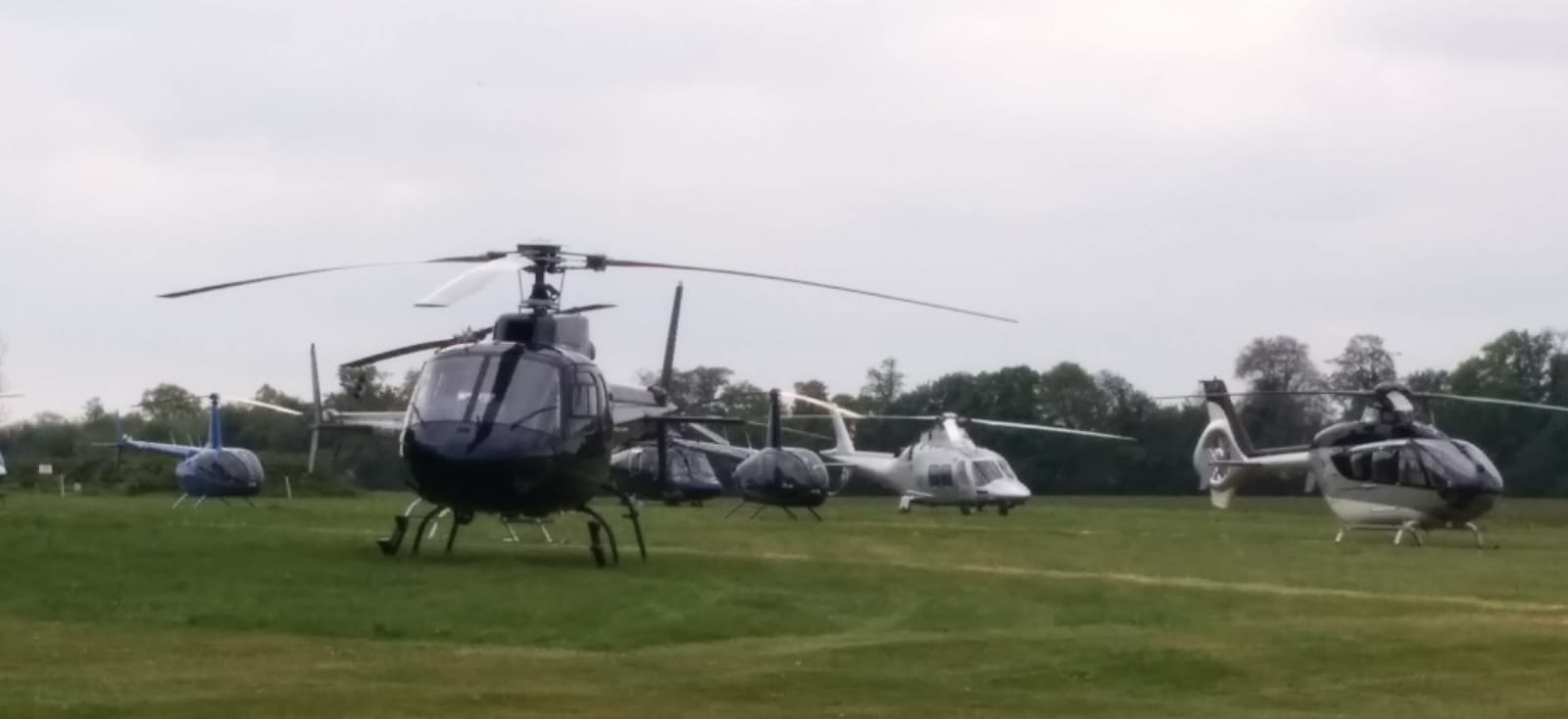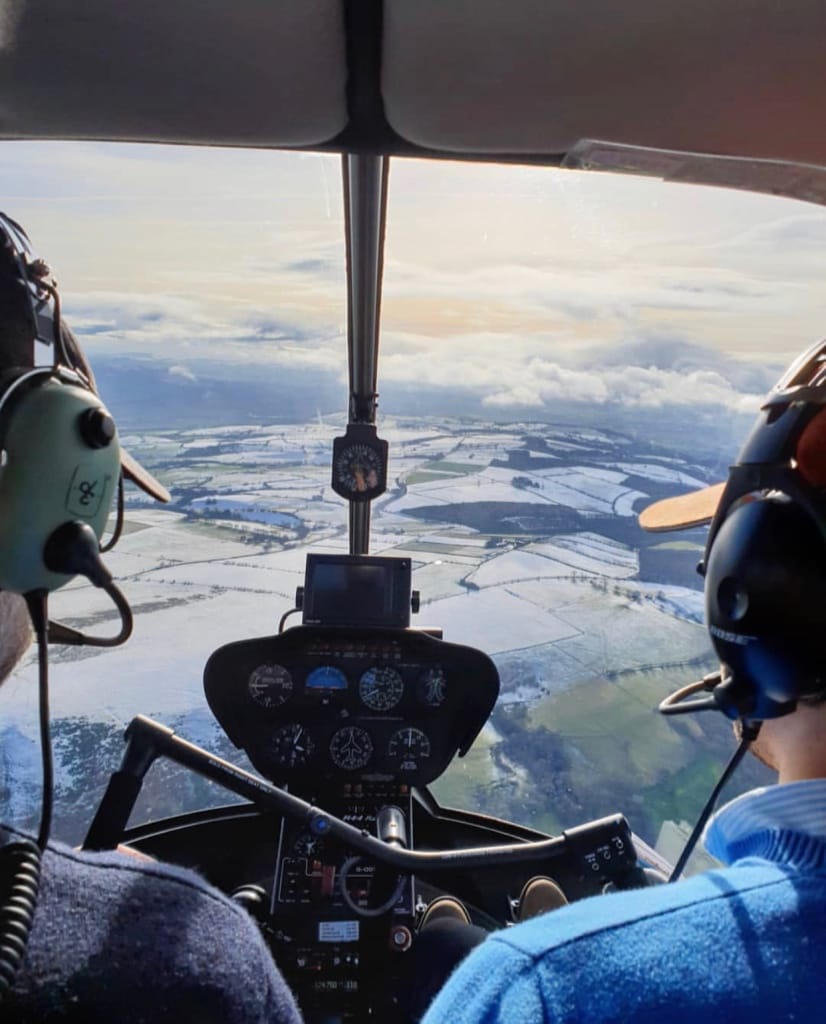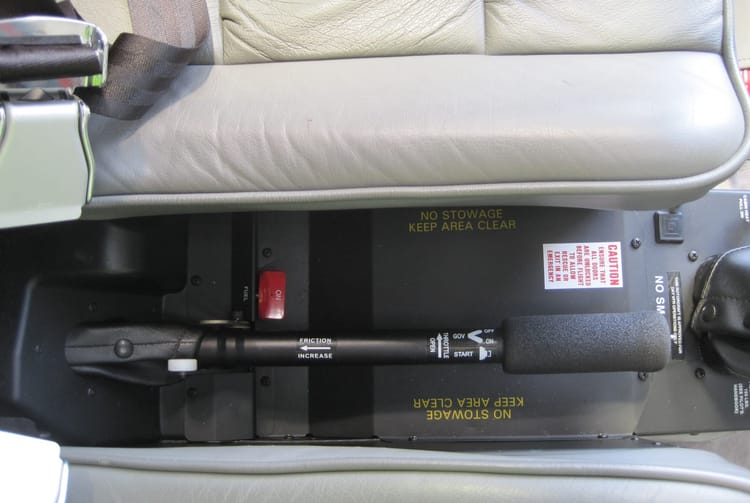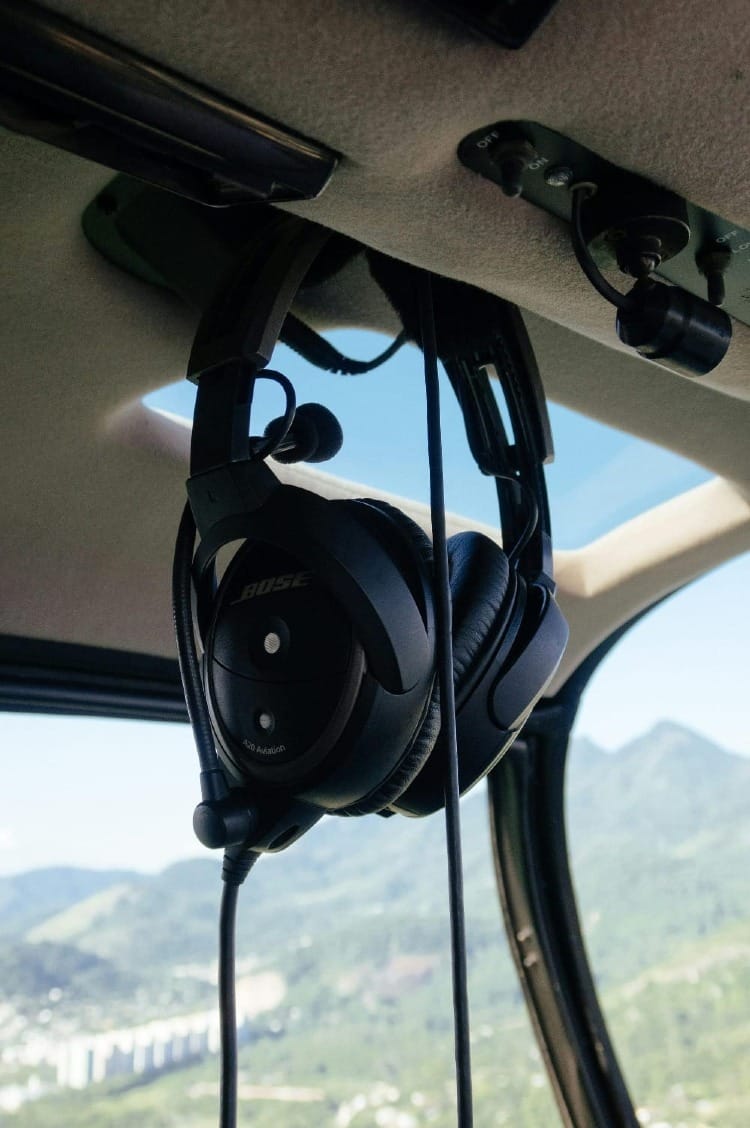Article: Start and manoeuvring: Is there space? Is it safe?

This article highlights the critical risks helicopter pilots face during engine start, run-up, and whilst manoeuvring near the ground. Evidenced by accident investigations, it describes how simple oversights turned into serious incidents. It emphasizes the importance of spatial awareness, pre-flight area checks, effective communication, and honest self-assessment of piloting ability. It offers practical safety lessons to help pilots avoid collisions with nearby helicopters, hangars, equipment, and other ground hazards.
Start and manoeuvring: Is there space? Is it safe?
I can count on one hand the number of times I’ve seen a helicopter with a 2-bladed main rotor parked with those blades sticking out to the right and left of the fuselage. They are almost always stopped fore and aft. This makes some sense: at least one blade is less vulnerable like this and the helicopter takes up less space in what can be a restricted environment. (For those of you who like to think of your your spacial environment in terms of numbers: Compared with the blades fore and aft, the 44 is almost 8m wider with blades to the left and right and the R22 almost 6m wider).
The upshot of this comes at the start of flight. After clutch engagement the rotors turn and the helicopter gets much wider than it was when you got in. Or, if you prefer, people, hangars, fuel bowsers, and so on, get closer. This just adds to the difficulty of managing the multiple threats the surroundings pose when we start and manoeuvre the helicopter. We’re very vulnerable at these points of flight. And this despite still being on the ground, in the hover or a slow hover taxi. Get it wrong and this is the kind of outcome we face:
An R44 lifted, moved slowly backwards and made contact with a parked R44. It then…
“…. pitched rapidly to 45 degrees nose down….. the nose pitched up, the tail struck the grass and the rear of both skids hit the concrete…… bounce approximately 2 feet from the ground, into a nose down attitude, while the tail turned anti-clockwise…… impacted the ground heavily….. rolling onto its right skid and pitching nose-up until the tail struck the ground….. bounced a second time, its tail turned quickly clockwise….. rolled left until the main rotor blades struck the concrete pad…. struck the ground….. with its tail on the grass…... rotor blades stopped turning 33 seconds later….. debris being thrown several metres across the surrounding area.”
The “Starting Engine and Run-up” and “Takeoff” procedures in Section 4 of the POH instruct the pilot to check that the Area is Clear immediately before turning the ignition key to start the engine and immediately before raising the collective to lift. The trouble is at these points we’re strapped into our seat and have a severely restricted view of the helicopter’s surroundings. So these checks are never going to be anything better than steps in a continuing process that should start before we get in.
Some threats, and some errors to avoid:
Case 1. The R22 had been hot re-fuelled from a bulk fuel tank installation. In the subsequent transition from the hover to forward flight the helicopter rolled rapidly to the right and hit the ground. The investigation concluded it was likely that the R22 had become entangled with the re-fuelling hose and pump during the departure.
Case 2. As the R22 hover-taxied over an area of rough ground a large piece of green plastic sheet that the pilot had not noticed blew upwards into the tail rotor. The helicopter began to spin to the right and the pilot closed the throttle and raised the collective lever. It was still turning when it landed and it came to rest on its left side.
Case 3. The R44 was parked on an apron with a parked vehicle “immediately to its right.” Having started the helicopter the pilot brought it to a hover. Whilst doing so he felt “unusual and severe vibrations”, apparently from the main rotor. He lowered the collective lever to land, the helicopter yawed to the left and the tail boom struck the parked vehicle. A subsequent engineering investigation did not reveal any abnormality in the main rotor or its control system.
Case 4. The R44 was parked on a ramp in front of a hangar which had an open bifold door extending approximately 10 feet out over the ramp. Video evidence described in the report shows that the R44 was brought to the hover, where it paused for a few seconds before beginning to climb out. As this point the main rotor contacted the open hangar door. The helicopter subsequently impacted the ground.
Case 5. Having no ground handling wheels and with convective activity approaching the pilot hover-taxied the R44 into a hangar. The next day he attempted to hover taxi the R44 out of the hangar. One or both main rotor blades struck the hangar door and the R44 spun and rolled onto its left side.
Case 6. An R22 was parked at a refuelling area. An R44 was subsequently parked next to the R22. Later the R22 was run up in preparation for flight. Just before lift off the student pilot and instructor on board experienced a “sudden bang and a massive vertical vibration”. The main rotor blades of the R22 had struck those of the R44 which had just started up.
Case 7. The R22 was parked with a fuel drum approximately one metre to its left and an approximate 15 knot wind from its right. The pilot and a passenger were on board and the aircraft was close to its maximum all-up weight. Once in the hover the R22 was weathercocking and difficult to stabilise. As the pilot looked to his right to check the area was clear the helicopter yawed to the right. The rear of the left skid hit the fuel drum and the R22 rolled onto its left side.
Case 8. This accident involves two R44 helicopters. For this summary I’ll refer to them as R44-1 and R44-2. R44-1 was on a helipad with rotors running prior to take off. R44-2 returned from a flight and landed on a grass area behind R44-1, the helipads being occupied. The pilot of R44-2 announced on the local frequency that his aircraft was “secure on the ground complete” then turned off the aircraft radio and removed his headset whilst the rotors slowed. One minute after the transmission from R44-2 the pilot of R44-1 received the latest airfield information by radio. This did not contain an alert to the presence of R44-2 on the grass area. He then announced his intention to lift and hover taxi to a holding point and he brought R44-1 to the hover. Due to the presence of stationary aircraft on the ground the movement of R44-1 was restricted so the pilot opted to move the helicopter rearwards. He knew that this area was clear when he boarded the helicopter and did not recollect hearing any radio transmission from R44-2. He did not turn R44-1 to check the area behind it was clear due to the presence of a parked R22 on his right as well as buildings and, he believed, spectators on his left. As R44-1 moved slowly rearwards one of the slowly turning main rotors of R44-2 stuck the engine housing of R44-1. The pilot of R44-1 heard a bang and recalled that the helicopter “pitched nose-up and right”. There then followed a series of control inputs and helicopter movements in which the tail and main rotor blades struck the ground. Finally R44-1 landed heavily with its tail resting on the ground.
It’s worthwhile reading the Case 8 report in full as it’s one in which a lot is going on. It provides useful lessons for operators and pilots beyond those highlighted below.
Safety Lessons:
Whether it’s hangars, helicopters, vehicles or fuelling equipment the surroundings can be brutally unforgiving when we start and manoeuvre a helicopter. It’s almost unfair: Make a minor low speed control error whilst driving a car – slowly reverse into a wall for example – and the car might suffer a small dent. The driver, passengers and the wall are all fine and the event would barely register with a passer-by. In no way does it become a life event for those involved. Make a similar error in a helicopter and all hell breaks loose.
We have to be on our game all of the time. So what lessons are there to help us avoid repeating these accidents?
Check the area for obstructions before getting into the helicopter (Cases 1,2,4,5,6).
Here “obstruction” covers a lot of things: From small sheets of plastic to buildings and other aircraft, vehicles, people. All can cause us a problem. Is there anything near or even resting on the skids: Ground-handling wheels, an earthing cable, a ladder, a fuel hose, a step, luggage? Is there any debris that might be a hazard – either by catching the skids or blowing into the rotors? If this could be obscured by, for example, long grass then walk the area around the helicopter and, as far as practical, the direction in which you’ll hover taxi. And remember to look up as well. That’s where we’re going and up there we can run into overhanging tree branches, protrusions from buildings and – most insidious of all – wires.
And ideally we should be a little creative before we get in. Not only have a thorough scan for what’s already there but anticipate what could be there by the time we’re ready to lift. Are any aircraft, that might restrict our manoeuvring, due to arrive before we depart? If we’re at base/an airfield then Operations personnel and/or other pilots might be able to help with this. It’s useful to get a heads-up before immersing our focus in the cockpit.

Be aware of what’s going on around you during start and run-up (Cases 6,8).
Not an easy thing to do. The start and run-up procedure is a heavy draw on our attention and until we’ve done it many times it’s difficult to shift our visual and auditory focus, however briefly, to what’s going on outside of the helicopter. It’s a good idea to build in to the start and run-up procedure more than one point at which you’ll pause briefly and take stock of what’s going on around you. And remember, when you're about to start the engine or take off, be aware that the helicopter surroundings may not be the same as when you climbed into your seat.
Make sure there’s enough space for YOU to bring the helicopter to the hover (Cases 3,5,7).
We all have limitations. We need to make a realistic assessment of the space around the helicopter we are about to fly and and ask ourselves the hard truth: Do I have the skill to bring it to the hover and manoeuvre as needed in the space available? And if there’s a strong gust of wind or a distraction, can I still do it without hitting the hangar/helicopter/vehicle/fuel drum?
One of the joys of learning to fly is looking back on how much the space you need to hover reduces with practice. If you’re reading this and your hover still takes up most of a football pitch, then stick with it. You’ll be amazed at what you can do in the future. Just be conservative when estimating your ability at any point in time.
Don’t fly the helicopter in a hangar (Case 5).
We’ve all thought about it and all want to give it a go just to see if we could do it. Seriously, how cool would it be?! Resist the temptation! Even if we’ve got fantastic spatial awareness and handling skills we’re likely to face aerodynamic and so handling issues that we can’t overcome. These will be worse if trying to lift and fly out. Get up to speed on the aerodynamics of helicopter flight if it’s not already clear to you what these issues are.
Will that other helicopter be too close when its rotors are running? (Case 6)
It’s safest to assume that two helicopters to be positioned next to each other will be operating at the same time and to space them accordingly. If you’re about to start is there going to be a conflict if the adjacent helicopter then starts? If their rotors are already turning is there now space for you to start?
And on arrival, before you set down: I see a pilot seated in that helicopter. If I park here and they engage their rotors before mine have stopped fore and aft, is there going to be a conflict? Remember, not all pilots will be as aware of a possible conflict as your are. You might have to do the thinking for them.
Announce your arrival and position (Case 8).
Does the pilot of the helicopter soon to depart know we’ve just set down out of their sight, behind them or off their back left quarter? When communicating that we’re on the ground and shutting down it can be helpful to add a comment indicating your location to make other pilots aware of it.
Be able to communicate with other aircraft (Case 8).
We’re operating in the vicinity of other aircraft and sitting in the helicopter. Whether about to start or shutting down, we need to be able to warn other aircraft or ATC of any developing conflict. This means having our headset and radio on as soon as practical after getting into the aircraft and keeping them on until we are about to step out again.
Sources of information
The Helicopter Safety Project Articles are built with gratitude on the work of others: The air accident investigators and the many pilots who, in the best spirit of promoting aviation safety, spoke candidly about the errors they had made in the accident chain of events. The main source material is air accidents investigation reports published on Government aviation accident investigation sites. For accuracy in summarising each report I’ve stuck closely to the wording used within. At times I’ve presented short pieces of text verbatim and in these cases I’ve put the text in quotation marks. Each investigation report is referenced below and can be viewed by searching the accident number and the aircraft registration via an internet search engine or through the relevant government organisation. As well as the documented reports, in some Articles I've thrown in a lesson learnt from my own experiences of flying and of teaching flying. Where primary research papers and reviews are referenced they can be accessed through PubMed – the search engine on life sciences and biomedical topics maintained by the United States National Library of Medicine.
Case 1: Australian Transport Safety Bureau. Aviation Safety Investigation report 200401866. Robinson R22 Alpha, VH-JWG.
Case 2: UK Air Accidents Investigation Branch. Bulletin 7/97. Investigation report EW/G97/05/23. Robinson R22 Beta, G-BSCE.
Case 3: UK Air Accidents Investigation Branch. Bulletin 5/2015. Investigation report EW/G2014/12/03. Robinson R44 Raven II, G-HECK.
Case 4: USA National Transportation Safety Board. Aviation Accident Final Report. Accident number CHI04LA212. Robinson R44, N7036J.
Case 5: USA National Transportation Safety Board. Aviation Accident Final Report. Accident number GAA17CA165. Robinson R44 Raven II, N804DF.
Case 6: UK Air Accidents Investigation Branch. Bulletin 9/2005. Investigation report EW/G2005/04/19. Robinson R22 Beta, G-CDBG and Robinson R44 Astro, G-OLOW.
Case 7: Australian Transport Safety Bureau. Aviation Safety Investigation report 199800537. Robinson R22 Beta, VH-LKK.
Case 8: UK Air Accidents Investigation Branch. Bulletin 10/2018. Investigation report EW/G2018/05/07. Robinson R44 Raven, G-CTFL and Robinson R44 Raven, G-HYND

Aviation Disclaimer
This ‘Article’ is produced by The Helicopter Safety Project (‘we’, ‘us’) on thehelicoptersafetyproject.co.uk. The Article cannot and does not contain aviation advice. The aviation information within the Article is provided in good faith for general informational and educational purposes only and is solely aimed at improving safety during the operation of helicopters. It is not a substitute for professional advice.
The aviation information does not in any way replace or override the instruction you may receive from a flying instructor at a flying training organisation or from a professional maintenance technician/engineer at an aircraft maintenance organisation or at an aircraft manufacturer. No information in the Article overrides or supersedes the Pilot’s Operating Handbook and the Flight Manual or other authoritative information published by the manufacturer of the aircraft being flown. Official documentation changes so the information in the Article might contain technical inaccuracies as a result.
The information, analysis and safety lessons in the Article under no circumstances should be considered to take precedence over the official air accident investigation reports and aviation safety advisory documents published by government organisations. The adoption of the safety lessons is not mandatory, it is subject to voluntary commitment and engages only the responsibility of those who endorse these actions.
The information sources listed within the Article are not investigated, monitored, or checked for accuracy, adequacy, validity, reliability, availability, or completeness by us. We do not warrant, endorse, guarantee, or assume responsibility for the accuracy or reliability of any information within these sources.
Before taking any actions based upon the information in the Article, we encourage you to consult with the appropriate professionals. Under no circumstance shall we have any liability to you for any loss or damage of any kind incurred as a result of any information provided in the Article.

